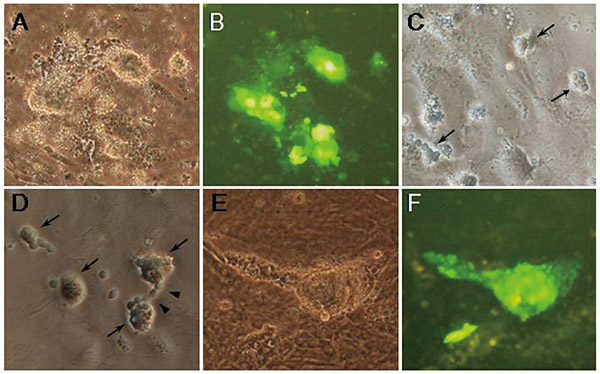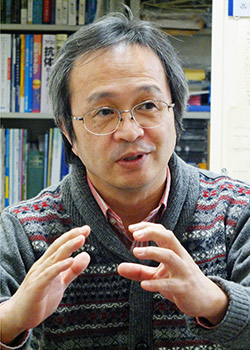酒井 則良 准教授(さかい のりよし)

- 小型魚類開発研究室 酒井研究室
- 愛知教育大学卒業、金沢大学大学院にて学術博士を取得。基礎生物学研究所特別研究員、福井県立大学講師、マサチューセッツ工科大学客員研究員、福井県立大学助教授を経て、2004年より国立遺伝学研究所
ゼブラフィッシュの生殖細胞を培養し、遺伝子改変技術を確立したい
酒井先生が目指しているのは、ゼブラフィッシュの生殖細胞(精原幹細胞)を自由自在に遺伝子改変し、それを分化させた精子から、遺伝子改変ゼブラフィッシュを作成できるようにすること。
多くの研究者に使ってもらえる研究ツールとなるような、細胞培養系と遺伝子改変技術の開発に挑んでいる。
この研究の過程で、助教の新屋さんと共同でゼブラフィッシュの近交系の樹立にも成功している。
- ゼブラフィッシュでマウスと同じ遺伝子改変技術を作るのは難しい
- 「ゼブラフィッシュは、世代交代が早く、体が透明なので初期発生過程が見えて、脊椎動物であるという理由で選ばれた研究材料なんですね。1980〜80年代にかけて使われるようになってきた。突然変異体を使った初期発生の研究が進んでいますが、マウスで標準的に用いられている近交系もありませんでしたし、遺伝子改変技術はまだ十分ではありません。」
- マウスの研究ではよく使われている「ES細胞」は、ゼブラフィッシュでは原理的に作ることができないという。
- 「魚の場合は受精卵の細胞質の中に生殖細胞のタネがあり、卵割のときに、その部分を受け取った細胞だけが生殖細胞になります。これを母性因子と呼んでいます。
そのため魚類では、発生のごく初期の割球しか『万能性』はないだろうと考えられます。
だから初期胚の細胞をいくら培養しても、ES細胞のような生殖細胞にも体細胞にも分化する幹細胞はできない。
ゼブラフィッシュを研究材料にしようと思った場合には、有利なこともあるけど、まだできないこともいっぱいあります。」 - そのため酒井先生は、遺伝子改変ゼブラフィッシュを作成する方法として、精原幹細胞を培養して遺伝子改変し、精子まで分化させるというやり方を選んだ。分化させた精子は人工授精するが、魚類では、紫外線を照射して遺伝子を不活性化した卵に受精させて雄性発生処理することで、精子のゲノムのみの次世代を作ることもできる。
- 「私がこの研究を始めた頃はまだゼブラフィッシュに母性因子があることはわかっていませんでした。マウスのES細胞を使った遺伝子ノックアウトの研究が非常に盛んだったので、私もゼブラフィッシュのES細胞を作ろうとしましたがうまくいかない。たまたま精巣を培養してみたら、思いがけず精子まで分化が進みました。それで、ゼブラフィッシュで遺伝子改変技術を作るには、初期胚の細胞より精原細胞を培養する方が向いているな、と思ったのが今の研究のきっかけです。」
-

図- ゼブラフィッシュ精原幹細胞の培養。
A, B.vas::efgp精原細胞の培養3日目。
C. 培養4日目で1回目の継代直後。矢印は精原細胞を示す。
D. 培養10日目で2回目の継代直後。矢頭は精原細胞が鎖状につながったところを示す。
E, F. 培養30日目。生殖細胞特異的なGFPが発現している。 - トライ&エラーで少しずつ目標に近づく
- 生体では、細胞同士が相互に情報伝達しあうことで、正しく増えたり分化したりしている。
培養においては、その状態を試験管の中で人工的にどう再現するかが難しい。 - 「はじめに樹立したのは、『分化型の精原細胞』を精子まで分化させる培養系です。培養過程で精原細胞に遺伝子導入して遺伝子改変ゼブラフィッシュを作出できました。ただ、その方法ではどうしても遺伝子導入効率があがらず、今の『精原幹細胞』の培養系に実験系をシフトしました。
培養の条件は、精巣の遺伝子発現情報や他の生物の情報を利用したり、あるいはたまたまだったり、いろいろトライ&エラーですね。
例えば、『分化型の精原細胞』の培養は、フィーダー細胞(培養の環境づくりのため補助的に使う他の細胞)にがん化した精巣から得たセルトリ細胞株というものを使っていました。『精原幹細胞』の培養でも同じように培養したのですが、うまくいきませんでした。あるとき、別のがん化精巣が見つかって、新たなセルトリ細胞株を樹立する目的でフィーダー細胞なしで培養したのですが、驚いたことに精原幹細胞がよく増えてきたんですね。詳しく調べてみると、セルトリ細胞株よりも、精巣細胞を撒くときに含まれるフレッシュな(株化していない)セルトリ細胞の方がいいことがわかりました。
培養液についても、こういう増殖因子を入れてやったら前より増える、他の増殖因子を入れても前より増える、じゃ、両方入れたらどうなるか?だめという場合もあれば、もっと良くなるという場合もあって、それをいろいろ組み合わせてなるべく長く良い状態を保つ。その結果、今、培養はできています。徐々に良くなってるんですね。まだできていないのは、目的の遺伝子改変をする、というところですね。ここが結構難しくて、なぜか生殖細胞は遺伝子を入れてそれを発現させるのが難しい。遺伝子は入ってるんですが、発現がいつの間にか消えてしまったりする。何か予想できないことが起こっている。生殖細胞固有の、遺伝子改変を受け付けにくくなっている何かがあるかもしれない。それが将来わかってくれば面白いんだけど。」 - この研究分野は競争が厳しいのだろうか?
- 「マウスでは精原幹細胞が多能性幹細胞に変わりうることがわかって、注目されていますが、ゼブラフィッシュで、こんな面倒くさいことを多くの人はやらないと思います。『分化型の精原細胞』培養系でノウハウを持っていたこと、その培養系でいい遺伝子改変技術を作れなかったことで、やるのであれば私たちしかいないと、ある意味開き直って進めています。」
- 技術が確立すれば多くの研究者に利用してもらいたい。遺伝研のナショナルバイオリソースプロジェクトの一貫として、遺伝子改変ゼブラフィッシュを提供できるようにしたい、と酒井先生は考えている。
- 独自の研究をやる
 酒井先生は理科の先生になろうと思って教育大学に入ったが、研究室での実験で、その面白さにはまった。
酒井先生は理科の先生になろうと思って教育大学に入ったが、研究室での実験で、その面白さにはまった。- 「予想をつけて自分で実験をやってみたら思った通りになった!その手ごたえが研究の魅力です。生物学の良さは、個人の思考で、しかもそれを個人で検証できて、把握できるというところだと思います。」
- 研究者として苦しいのは、成果が出ないときだという。
- 「ずっと、自分にしかできない研究をしたいと思ってきました。ただ、面白そうだなと思う仕事ほど成果が出にくいんです。
成果を出すということと、面白いことをやるということのバランスをいかに保つかというところが苦労です。
くじけそうなときは、ごくちょっとした進歩をハッピーと思うことですね。
ネガティブな結果が出ても、もうこっちはやらないでいい、とわかることだから、それもハッピーです。(笑)」 - 好きな本は寺田寅彦の随筆集で、科学的であり詩的な独特の世界が非常に面白いと言う酒井先生。
最後に、学生さんへのメッセージを聞いた。 - 「こうじゃないとダメだとか、こんなはずじゃなかった、っていうふうにあまり自分の理想に縛られないでほしい。ゼブラフィッシュのES細胞を作ろうとして、精原幹細胞の培養系にたどり着くこともありますから。塞翁が馬でもいいように思います。」
- (田村佳子 インタビュー 2013年12月)















